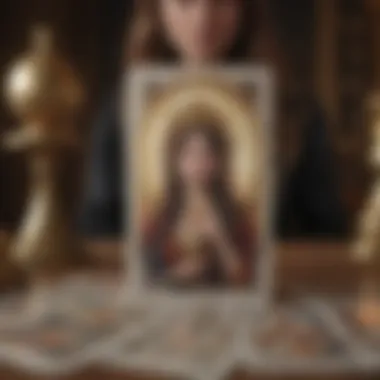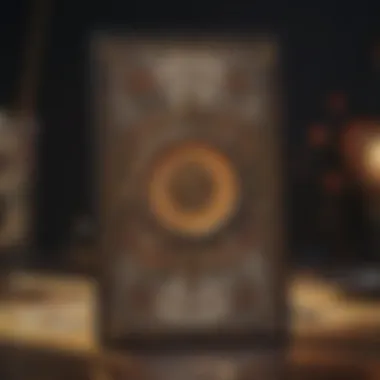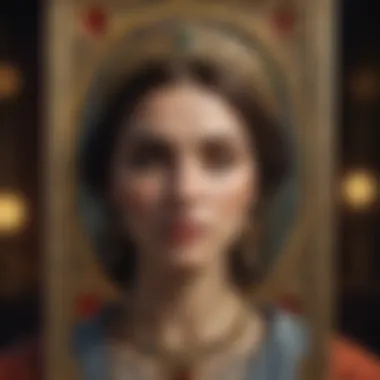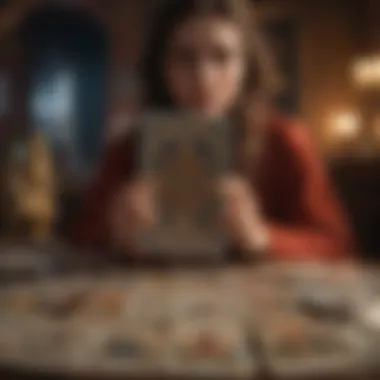Unlocking Hidden Insights: Reversed Tarot Meanings


Intro
The art of tarot reading encompasses a wealth of knowledge and intuition, where each card holds a myriad of meanings. When cards appear in a reversed position, their significance transforms. Understanding these reversed meanings is essential for anyone looking to deepen their tarot practice. This article will explore the intricacies of reversed tarot cards, offering an insightful guide to enhance readings.
By examining the nuances of reversed cards, readers will discover the alternative interpretations these cards unveil. This exploration will not only expand the toolkit of seasoned tarot practitioners but also benefit beginners. It lays the groundwork for more intuitive and informed readings, ultimately enriching the practitioner's connection to the cards.
The Essence of Reversed Meanings
Reversed tarot cards often flag noteworthy subtleties in the reading’s narrative. While upright cards convey straightforward messages, their reversed counterparts frequently indicate blockages, inner struggles, or alternative points of view. This complexity is what makes the tarot read an art form.
As practitioners grapple with each card's duality, they approach readings with an openness that enhances the experience. Familiarity with reversed meanings can guide the reader to parse critical shifts in energy.
Key Points to Explore
- Significance of reversals in individual cards
- Identifying patterns when interpreting reversals
- Practical examples showcasing varied interpretations based on card placements
Within this guide, tarot enthusiasts will find a range of resources to support and refine their understanding of reversed meanings, paving the way for more profound tarot readings.
Prologue to Reversed Tarot Cards
Exploring the world of tarot cards is a journey into symbolism and intuition. One crucial aspect is understanding reversed tarot cards. This area warrants attention as it opens up the possibilities for richer interpretations. Reversed cards can generate contrasting themes compared to their upright counterparts. This depth can change the meaning of a reading significantly.
Definition of Reversed Cards
Reversed cards refer to those tarot cards that appear upside down in a reading. This position often indicates a different layer of meaning. For example, a card like The Fool might suggest carefreeness when upright but indicate foolishness when reversed. Each card holds dual potential, and the reversal adds complexity. Thus, the interpretation of reversed cards is not merely about negating the upright meaning but rather understanding the nuances they bring.
Historical Context of Reversed Astrology in Tarot
The history of reversed tarot cards is intertwined with the evolution of tarot itself. Initially, many tarot decks did not embrace the concept of reversals. Early users focused on upright meanings. However, as tarot practices evolved, so did the understanding of reversals. Historical texts show varying opinions on their significance. In some traditions, reversals were seen as shadows of the upright meanings, while others regarded them as separate insights altogether.
The acceptance of reversed meanings is seen in modern tarot practices. Notable figures in tarot history, such as Aleister Crowley, emphasized the need to consider reversals. This perspective allows for a more dynamic interpretation, which can lead to deeper understanding in readings. Reversed meanings can empower practitioners to reveal hidden aspects of a querent’s life, aiding in more comprehensive understandings.
Understanding reversed tarot cards adds significant value. It offers insights that can go unnoticed when only focusing on upright meanings.
Why Reversals Matter
Understanding reversed tarot cards is vital in the realm of tarot readings. Their significance is often overlooked or mistaken for simple negativity. This perspective misses the profound insights that reversals can offer. Reversed cards introduce complexity and depth. They can expose hidden dynamics and emotional undercurrents. By engaging with these cards, tarot practitioners can achieve a richer understanding of the situation at hand.
When reading tarot, reversals give voice to energy shifts. They provide clues about imbalances that may otherwise remain obscured. This can alert the reader to aspects of a situation needing attention or reevaluation. Thus, learning to interpret these cards effectively enhances the quality of the readings.
Benefits of recognizing reversed meanings include:
- Enhanced clarity: Reversals can clarify confusion present in upright cards.
- Broader perspective: They offer alternative interpretations that may reflect the querent’s true state.
- Cautionary insights: Some reversals warn against potential pitfalls that may not be apparent.
The importance of this topic cannot be understated. Acknowledging the reversed meanings can transform a reading from surface analysis to deep exploration, fostering greater understanding both of the cards and the situations they depict.
The Role of Energy Flow
Reversed cards often indicate a disruption in energy flow. In their upright positions, tarot cards typically reveal a straightforward reading of the situation. However, when reversed, they suggest blocks or misalignments in energies. For example, the Fool reversed indicates a lack of direction, while the High Priestess reversed may signal an intuitive blockage.
In tarot, energy is not a static concept. It shifts and changes, influenced by various factors. When readers consider reversals, they must pay attention to the movement of energy around them.
Consider an individual struggling with self-confidence. If the Strength card appears reversed, it may reflect inner turmoil or feelings of inadequacy, rather than simply suggesting a lack of bravery. Recognizing this impact is essential for accurate interpretation.
Clarifying Situational Contexts
Reversals are particularly useful in giving context to specific situations. They shed light on nuances that upright cards might not convey. A reversed card in a reading signals that the energy surrounding a particular theme could be contradictory or complex. This underscores the reader’s need to delve deeper into circumstances at play.
For instance, a reversed Cup card might reveal emotional dissatisfaction or instability, contrasting with the upright meaning of emotional fulfillment and harmony. This distinction is important for providing relevant advice or insights.


By contextualizing reversals, each reading becomes more tailored. Readers can discern not just what the cards represent in a conventional sense but also how they were meant to apply to the individual's unique experiences.
"Reversals do not just signify negativity; they often reflect the hidden aspects of growth and transformation."
In summary, the role of reversals in tarot cannot be underestimated. They enrich readings with detail and context. Engaging with reversed cards challenges the reader to expand their interpretive skills, ultimately leading to more insightful tarot readings.
Major Arcana Reversals
The Major Arcana holds a significant place in Tarot readings, representing life's key lessons and experiences. These cards encapsulate deep psychological and spiritual insights. When reversed, Major Arcana cards can reveal hidden conflicts or blockages that the upright positions might overlook. This unique perspective offers layers of meaning that enhance the overall reading, directing one’s awareness to issues that may need urgent attention. Understanding these reversals helps practitioners get more nuanced interpretations, thus enlarging the scope of Tarot as a self-awareness tool.
The Fool Reversed
The Journey To Foolishness
The Fool, when reversed, often represents a journey not taken or a direction that strays from the intended path. It can signify recklessness or a failure to embrace one's full potential. The key characteristic here is impulsivity, where the querent may leap into decisions without considering consequences. This is beneficial for understanding what leads one to foolishness, shedding light on patterns of behavior that lead to missed opportunities. Its unique feature is the revelation of lessons learned through misguided approaches, often highlighting emotional or spiritual growth. The disadvantage, however, is that it may evoke feelings of regret or frustration.
Implications for New Beginnings
In the context of new beginnings, The Fool reversed indicates delays or indecision. This may pose significant challenges for those seeking to start anew. The essence lies in hesitation, reflecting a lack of courage to pursue what might be beneficial. This aspect is essential because it reveals the barriers to fresh starts, prompting a reevaluation of motivations and readiness. A unique feature includes the potential to explore fears associated with change. However, one must be cautious, as it can manifest as stagnation if not addressed.
The Magician Reversed
Manipulation Versus Manifestation
The Magician reversed warns against deception and exploitation. This card represents a disconnect between intention and action. The vital element here is the abuse of skills or resources, which can lead to manipulation, affecting others negatively. For this article, it provides insight into the delicate balance between positive manifestation versus harmful manipulation, serving as a warning against unethical behavior. Its unique feature is the emphasis on using personal power responsibly, a key lesson derived from observing misconduct. One downside is that it can create distrust in personal capabilities.
Challenges in Skill Utilization
Challenges in skill utilization are a prominent theme with The Magician reversed. This can occur when abilities are underutilized or misapplied, leading to feelings of inadequacy. The key characteristic is a lack of confidence, which can hinder progress and foster a sense of frustration. Understanding this reversal exposes barriers to effective communication and creative expression. A unique feature lies in recognizing that the querent may need external guidance to harness their full potential. However, this can lead to dependency if they remain unaware of their innate skills.
The High Priestess Reversed
Intuition Blockages
Intuition blockages emerge prominently with The High Priestess reversed. When this card appears, it signals an internal conflict that prevents clarity. This blockage leads to challenges in connecting with deeper insights or understanding emotional landscapes. The key aspect is the loss of inner guidance, which can manifest during crucial decision-making. For readers, it provides a gateway to explore areas of emotional resistance or denial. It serves as a reminder to seek inner truth. The unique feature of this aspect is that it encourages work towards reclaiming one's intuition. Yet, the disadvantage is the emotional turmoil it may reveal.
Impacts on Spiritual Awareness
The spiritual implications of The High Priestess reversed can be profound. It often suggests disconnection from spiritual practices or beliefs. The vital characteristic here is the sensation of being out of alignment with one’s higher self. Understanding the impacts on spiritual awareness allows individuals to recognize areas where they might retreat from their practices. A key advantage is the opportunity to reassess and reconnect with one’s spiritual path. However, it can also provoke feelings of isolation, making it difficult to engage in community or shared beliefs.
Minor Arcana Reversals
Minor Arcana cards play a pivotal role in tarot readings, often reflecting the nuanced day-to-day aspects of life. When interpreted in reverse, these cards can reveal deeply personal challenges and dynamics. Understanding the meanings of reversed Minor Arcana cards enriches a reader's insight, allowing for a more comprehensive interpretation of a situation. Each suit—Cups, Swords, Wands, and Pentacles—offers distinct messages when reversed. This depth is valuable for enthusiasts eager to refine their interpretations and enhance their readings.
Cups Reversed
Emotional Imbalances
Emotional imbalances manifest prominently in the reversed Cups. This aspect underscores the misalignment often felt in interpersonal connections. When Cups appear reversed, they often signify feelings of overwhelm or detachment. As a result, they guide readers to acknowledge the emotional turbulence that may be affecting their relationships. This topic appeals to many because it highlights the importance of emotional health and how it influences one's social interactions.
In reading reversed Cups, it becomes clear that the message is about confrontation with one’s emotions rather than avoidance. Addressing these imbalances can lead to self-awareness and healing. Thus, understanding this emotional aspect is essential for anyone seeking to provide deeper insights in their readings.
Difficulties in Relationships
The reversed Cups also reveal difficulties in relationships. This facet stresses the miscommunication and misunderstanding that often arise among partners, friends, or family members. It presents a challenge but also an opportunity for growth. By acknowledging these struggles, the reader can encourage clients to engage in open dialogue with loved ones.
Typically, enthusiasts find this angle beneficial, as it reveals how relationships evolve through conflict. The unique feature of this interpretation lies in its focus on the necessity for honest expression. Thus, while the reversed Cups can highlight negativity, they also promote the chance for healing through recognition of issues at hand.
Swords Reversed
Avoidance of Conflict


The Swords, when reversed, often indicate an avoidance of conflict. This particular aspect points to individuals who may retreat from challenges instead of confronting them. Such avoidance can foster stagnation and lead to unresolved issues. Therefore, understanding this can be crucial for those who seek clarity in their lives.
A key characteristic of this interpretation is its reminder of the need for confrontation. Some find it beneficial because it emphasizes the importance of facing conflicts head-on. Overall, this reading prompts a deeper introspection about how one approaches difficulties, perhaps urging readiness to address rather than evade.
Mental Turmoil
Mental turmoil is another significant meaning when Swords are reversed. This aspect highlights the inner chaos that can sometimes accompany decision-making or significant life changes. A reader might interpret this reversal as a signal to examine one’s thoughts more closely.
The unique feature here is the emphasis on mental clarity. Those familiar with Swords' meanings can appreciate that while the card often suggests conflict, its reversal opens a dialogue around internal debate. Readers will find that discussing mental turmoil helps in identifying patterns and prompts changes necessary for peace of mind.
Wands Reversed
Lack of Direction
When the Wands are reversed, a lack of direction is often noted. This aspect signifies feelings of aimlessness and uncertainty. A reader might see this as a call for introspection and reevaluation of goals. Understanding this can provide valuable insights into areas of one's life that feel stagnant or overwhelming.
The key characteristic here is the understanding of how passion fuels direction. Readers engage with this idea well as they connect it to their own experiences of both motivation and disillusionment. By discussing this lack of direction, one fosters a dialogue around goal-setting and reclaiming personal drive.
Abandonment of Passion
The abandonment of passion also emerges when reading reversed Wands. It often signifies a dwindling enthusiasm for projects or goals once held dear. Readers can identify this reversal as an invitation to rekindle one’s ambitions and explore underlying causes for the loss of excitement.
Highlighting the uniqueness, this interpretation presents an opportunity for revival. Enthusiasts find this particularly important because it sheds light on the need to examine what energizes them. By addressing this, they can assist clients in finding motivation once lost, making it a useful perspective in their readings.
Pentacles Reversed
Financial Instabilities
Financial instabilities are a common theme when Pentacles are reversed. This aspect sheds light on potential issues surrounding material safety. A reader interpreting this may interpret it as a warning against overspending or poor investments. By emphasizing this instability, it guides one to reassess their financial strategies.
Key characteristics of financial instability include unpredictability and anxiety about resources. This notion is appealing, particularly for those concerned about personal or business finances. Addressing this topic offers a chance to foster responsibility and mindfulness regarding money management.
Material Discontent
Material discontent showcases another layer when Pentacles appear reversed. It speaks to feelings of dissatisfaction with one's material possessions or lifestyle. This can manifest in a sense of lack despite potential abundance around. Readers can utilize this idea to encourage individuals to explore deeper desires beyond material possessions.
Uniquely, this interpretation emphasizes introspection and realignment with one’s values. Many find this helpful as it fosters a dialogue about what truly brings satisfaction. By addressing this discontent, readers can assist others in redefining their priorities and goals caught in a cycle of materialism.
Interpreting Reversed Cards in a Reading
Interpreting reversed cards in tarot readings is a vital component of understanding the full spectrum of meanings within the tarot deck. When a card appears in reverse, it can completely shift the context and implications compared to its upright position. Reversed cards often indicate internal struggles, challenges, or blocked energies. Therefore, they require specific attention and interpretation to grasp their significance.
The value in interpreting these cards lies in their ability to provide deeper insights into various aspects of life. Without this understanding, readers might overlook crucial nuances that could reveal critical advice, challenges, or warnings. Reversed cards can also reflect personal reflections of the querent, expressing what is happening beneath the surface.
Those who engage with reversed positions often find they provide clarity in chaotic situations. In a larger narrative, they can illuminate areas requiring growth or transformation, guiding the querent toward self-awareness. The duality of tarot cards embodies a rich complexity that becomes particularly pronounced in reversed readings, offering layers of meaning that enhance intuitive skills.
Contextualizing the Spread
To contextualize the spread when interpreting reversed cards, it is essential to consider the layout used and the relationship between each card. The placement of reversed cards among upright ones can shed light on how they interact with one another. For example, if a reversed card appears next to an upright card, it can suggest conflict between the two meanings. Additionally, understanding the spread's purpose can guide the reader into how to interpret each card effectively.
It is helpful to take note of the surrounding cards that may provide additional context. Consider the following strategies:
- Analyze the overall theme of the spread.
- Identify the emotional state of the querent related to the reversed cards.
- Look for any patterns that may emerge from the combination of upright and reversed cards.
By contextualizing the spread, readers can form a complete narrative that integrates the reversed meanings along with the upright cards.
Balancing Reversed and Upright Cards
Balancing reversed and upright cards is essential for a coherent reading. Each position represents contrasting energies and can create a harmonious dialogue. The upright cards can indicate positive guidance or strengths, while reversed cards may highlight obstacles or obstacles.
In practice, it is useful to:


- Compare the meanings of nearby cards to uncover potential interactions.
- Observe if the reversed cards echo any messages from the upright ones, providing a deeper understanding.
- Utilize reversed cards as a tool to delve into the querent's internal conflicts, while upright cards can present external situations or influences.
This balancing act encourages dynamic interpretation, leading to insightful readings that resonate with the querent. In essence, recognizing how reversed and upright cards influence each other fosters a richer exploration of the tarot's possibilities.
Common Misconceptions about Reversed Tarot Cards
Misunderstanding the reversed tarot cards can lead to inappropriate interpretations and missed opportunities for guidance. Many enthusiasts stick to a simplified view of reversals, limiting their understanding and the depth of their readings. Addressing these misconceptions is crucial for any serious student of tarot.
Understanding reversed cards requires a nuanced view of the energies present in each situation. They do not simply stand for negative outcomes or challenges. Instead, they provide critical insights that could enhance decisions and self-reflection.
Reversal Equals Negativity
This is perhaps the most pervasive misconception among those new to tarot. Many people instinctively link reversed cards with negativity or bad fortune. This misinterpretation can skew a reading, leading to an inaccurate perception of a situation.
In reality, a reversed card often indicates the need to reevaluate or reassess certain energies in life. For instance, The Magician reversed could suggest manipulation or confusion rather than outright failure. It may reveal internal struggles or issues that demand attention.
Reversals encourage deeper investigation of the meanings behind situations, highlighting areas needing growth or healing. They serve as valuable tools to confront uncomfortable emotions or aspects hindering progress. Instead of viewing a reversed card as purely negative, practitioners can see it as an invitation to confront and resolve underlying issues.
Reversals Are Difficult to Interpret
Many learners claim that reversed cards add complexity, resulting in interpretive difficulties. While it is true that reversals introduce additional dimensions to readings, this complexity can also enrich them. The key lies in understanding the nuance of each card and how it interacts with others in the spread.
Interpreting reversed cards requires practice and attentiveness to the feelings and intuitions that arise during a reading. It is helpful to connect reversals to the situation at hand, considering surrounding upright cards to clarify the overall message. Using resources such as reputable tarot guides or community discussions can make this process easier.
By embracing reversals as an integral part of tarot reading, one may develop a more profound comprehension of the dynamics surrounding different life situations. Rather than fearing complexity, one should embrace it, enabling the user to derive deeper insights and better clarity.
Practical Tips for Reading Reversed Cards
Reading reversed tarot cards requires a distinct approach, as they often illuminate complexities that upright cards may overlook. Engaging with reversed positions provides deeper insight into the dynamics at play in a reading. It enables the reader to explore both the shadows and the highlights of a situation.
Developing Your Intuition
Intuition is a vital component in tarot reading, especially with reversed cards. To cultivate your intuition, set aside time for meditation before your readings. This practice grounds you and creates a mental space to receive insights. Trust your gut feelings when you encounter a reversed card. It can signal a need for caution or signal an opportunity for reflection.
Here are practical ways to strengthen your intuition:
- Regular practice: Read cards frequently, paying attention to your immediate thoughts on reversals.
- Personal journaling: Document initial intuitive responses in a journal to track your growth.
- Meditative visualization: Visualize how reversals relate to the question at hand to uncover latent meanings.
Remember that intuition is personal; your insights may diverge from established meanings. Listen closely and allow yourself to connect deeply with the energy of the cards.
Documenting Your Readings
Recording your tarot readings, particularly those involving reversals, can enhance your understanding. A reading log serves not only as a reference but also as a tool for growth. Documenting each reading allows you to reflect on the meanings you attributed to reversed cards over time. This exercise strengthens your analytical skills and builds a reference to consult later.
When documenting readings, consider these pointers:
- Date and context: Always note the date and situational context in which the reading was done. This information helps in linking reversed meanings to specific phases in life.
- Card interpretations: Write down your interpretations of reversed cards without relying solely on guidebooks. Capture your intuition and thoughts during the reading.
- Outcomes: Note the outcomes. How accurate were your interpretations? Did the messages resonate? Reflecting on these aspects can offer insights into personal growth and mastery.
By nurturing your intuition and keeping detailed records of your readings, you enhance your understanding of reversed tarot cards. This attention to detail allows for a richer exploration of the intricate narratives embedded within each reading.
End
Recap of Key Insights
In summary, this article has outlined various aspects of reversed tarot cards. We explored the definition of reversed cards, their historical context, and why they matter in tarot readings. Major and minor arcana reversals have been meticulously dissected, revealing vital insights like:
- Emotional imbalances seen in reversed Cups.
- Avoidance of conflict indicated by reversed Swords.
- Financial instabilities expressed through reversed Pentacles.
Understanding and interpreting these are crucial for anyone serious about tarot. The exploration of misconceptions and practical tips provides additional support to deepen one’s skill set. This compilation offers tarologists the tools to confront their biases and see the bigger picture.
Encouragement for Continued Exploration
Embracing the complexities of reversed tarot cards opens doors to a more profound mastery of this ancient practice. For those who seek to progress, continuous learning is beneficial. Engage with your cards, contextually analyze your readings, and continually document your insights.
Consider participating in communities on platforms like reddit.com or facebook.com, where discussions on tarot are vibrant and diverse. Sharing experiences and interpretations can broaden your perspectives and enhance your observational skills.
The path of tarot is vast and multi-dimensional. Each reading presents an opportunity to see beyond the surface. Dive deeper into this mystical world and allow the reversed meanings to inform not just readings, but also personal growth.







